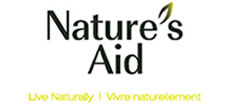The Kespukwitk Conservation Collaborative: In partnership to protect southwest Nova Scotia
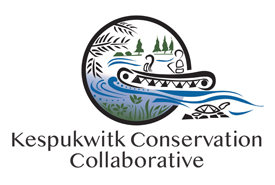
Working together to conserve species at risk and biodiversity in the Kespukwitk/southwest Nova Scotia
Did you know that 94 per cent of terrestrial species at risk in Nova Scotia can be found in Kespukwitk, the southwest region of the province? From forests to barrens, and wetlands to sandy beaches, this distinct area holds a diverse array of ecosystems.
Kespukwitk is one of seven districts in Mi’kma’ki, and is home to two Mi’kmaq Nations: Acadia First Nation and Bear River First Nation. The word “kespukwitk” (pronounced “ges-boog-wit-k”) means “land ends” or “end of flow” in the Mi’kmaq language. True to its name, Kespukwitk contains 2,813 kilometres of shoreline, stretching from the Bay of Fundy to the deep Atlantic Ocean.
Kespukwitk’s various landscapes make it a perfect location for a large variety of species, including 67 federal and provincial species at risk. Twelve of the 16 Key Biodiversity Areas in Nova Scotia are found here. Provincially endangered Blanding’s turtle and threatened eastern ribbonsnake thrive in the area’s wetlands and floodplain systems. A high concentration of rare Atlantic coastal plain flora species also grows in the wetlands and along lakeshores here, and black ash trees can be found in the forests.
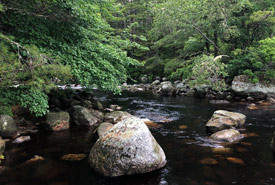
Moose Lake, NS (Photo by Doug van Hemessen/NCC staff)
Though Kespukwitk has long been a location of ecological significance, it wasn’t until 2017 that the area was officially recognized across Canada. That year, Kespukwitk was identified as one of 11 Priority Places for species at risk identified by the federal government. As part of the Pan-Canadian Approach to Transforming Species at Risk in Canada, these priority places would receive funding for various conservation projects. The idea is to emphasize an area-based approach to conservation, impacting entire ecosystems rather than individual species.
This new approach would help protect many more species at risk than previous conservation efforts had achieved. However, much coordination was required among local organizations in the priority places. Fortunately, the nature conservation community in Nova Scotia is strong, and they recognized a need to protect the natural landscapes of Kespukwitk prior to being allocated funding.
“Having worked in other conservation areas, what we have in Nova Scotia is really unique,” says Jaimee Morozoff, program director for the Nature Conservancy of Canada (NCC) in Nova Scotia. “Instead of competing for resources, there’s been a lot of collaboration, a lot of working together and a lot of opportunities to advance and enhance each other’s conservation.
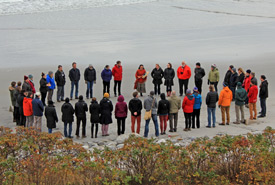
The Kespukwitk Conservation Collaborative (Photo by Lori Phinney/Mersey Tobeatic Research Institute)
The conservation organizations in Nova Scotia had already begun working on a new habitat conservation strategy for Kespukwitk when the priority places were announced. They quickly formed the Kespukwitk Conservation Collaborative (KCC) as an official establishment they could coordinate their efforts through.
KCC is comprised of Mi’kmaq First Nations, non-government organizations, academic institutions, and federal and provincial government departments. By working collectively under the title of the collaborative, the organizations are able to progress faster and convey more unified, evidence-based information to the public.
Etuaptmumk, meaning “two-eyed seeing,” is incorporated in KCC’s work. Conceived by Mi’kmaw Elder Albert Marshall, Etuaptmumk is a way of acknowledging both the strengths of Indigenous knowledge and western knowledge together. It is just one way that the Collaborative has embraced the diverse skills and expertise of its members.
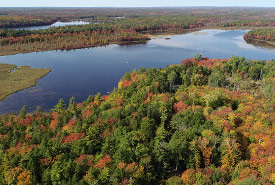
Upper Ohio, NS (Photo by Mike Dembeck)
“We all kind of have our specialties to some degree, but we are also finding ways that overlap so we can work together,” says Marie Racioppa, Atlantic conservation project coordinator for NCC. Marie previously worked with the Mersey Tobeatic Research Institute, another member of KCC, where she helped to develop an online presence for the collaborative.
All 18 organizations share information and resources, and discuss how they can collaborate on projects. Though they were already friendly, regular meetings allowed them to gain a better understanding of each other’s expertise, and to feel more comfortable when connecting outside of meeting times.
The connectivity of KCC has also been incredibly useful in organizing outreach. “Any changes we make are longer lasting,” says Marie, “and you need community support, I believe, for that to happen.”
Since Nova Scotia is largely made up of private land, it’s important that communities develop a positive relationship with the ecosystems around them. Wetlands, for example, play a major but little-known role in many communities’ livelihoods. They can prevent flooding, absorb carbon in the air and even purify water that communities may use for drinking.
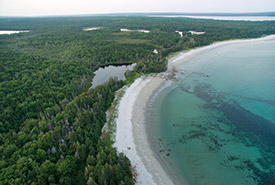
Port Joli, NS (Photo by NCC)
Information on Kespukwitk and KCC’s conservation work can be found at kswnsconservation.ca. This website functions as a central starting point for interested members of the public to explore options for volunteering, donation, educational purposes and more.
The Kespukwitk Conservation Collaborative is only the beginning. While the priority places funding is set to end in 2026, these organizations will continue to work together to protect Kespukwitk for years to come. If there is one thing they have proven, it’s that collaboration is essential for a long-lasting, positive effect on the beautiful and necessary nature around us.
Federal and provincial endangered species in Kespukwitk:
- bank swallow
- Barn swallow
- Blanding's turtle
- boreal felt lichen
- Canada warbler
- chimney swift
- harlequin duck
- little brown myotis bat
- mainland Nova Scotia moose
- monarch butterfly
- northern myotis bat
- pink coreopsis
- piping plover
- Plymouth gentian
- red knot
- rockrose
- roseate tern
- rusty blackbird
- tall beakrush
- thread-leaved sundew
- transverse lady beetle
- tricolored bat
- vole ears lichen
- water pennywort
For more information:


